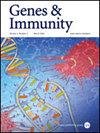TIMP-1 is an activator of MHC-I expression in myeloid dendritic cells with implications for tumor immunogenicity
IF 4.5
3区 医学
Q1 GENETICS & HEREDITY
引用次数: 0
Abstract
Immune checkpoint therapies (ICT) for advanced solid tumors mark a new milestone in cancer therapy. Yet their efficacy is often limited by poor immunogenicity, attributed to inadequate priming and generation of antitumor T cells by dendritic cells (DCs). Identifying biomarkers to enhance DC functions in such tumors is thus crucial. Tissue Inhibitor of Metalloproteinases-1 (TIMP-1), recognized for its influence on immune cells, has an underexplored relationship with DCs. Our research reveals a correlation between high TIMP1 levels in metastatic melanoma and increased CD8 + T cell infiltration and survival. Network studies indicate a functional connection with HLA genes. Spatial transcriptomic analysis of a national melanoma cohort revealed that TIMP1 expression in immune compartments associates with an HLA-A/MHC-I peptide loading signature in lymph nodes. Primary human and bone-marrow-derived DCs secrete TIMP-1, which notably increases MHC-I expression in classical type 1 dendritic cells (cDC1), especially under melanoma antigen exposure. TIMP-1 affects the immunoproteasome/TAP complex, as seen by upregulated PSMB8 and TAP-1 levels of myeloid DCs. This study uncovers the role of TIMP-1 in DC-mediated immunogenicity with insights into CD8 + T cell activation, providing a foundation for mechanistic exploration and highlighting its potential as a new target for combinatorial immunotherapy to enhance ICT effectiveness.


TIMP-1 是骨髓树突状细胞中 MHC-I 表达的激活剂,对肿瘤免疫原性有影响。
治疗晚期实体瘤的免疫检查点疗法(ICT)标志着癌症治疗的一个新里程碑。然而,由于树突状细胞(DC)对抗肿瘤 T 细胞的启动和生成不足,它们的疗效往往受到免疫原性差的限制。因此,确定生物标志物以增强树突状细胞在此类肿瘤中的功能至关重要。组织金属蛋白酶抑制剂-1(TIMP-1)因其对免疫细胞的影响而被公认,但它与直流电细胞的关系却未得到充分探索。我们的研究揭示了转移性黑色素瘤中高 TIMP1 水平与 CD8 + T 细胞浸润和存活率增加之间的相关性。网络研究表明了与 HLA 基因的功能性联系。对全国黑色素瘤队列进行的空间转录组学分析表明,TIMP1在免疫分区中的表达与淋巴结中的HLA-A/MHC-I肽负载特征有关。原代人类和骨髓源性 DCs 会分泌 TIMP-1,它能显著增加经典 1 型树突状细胞(cDC1)的 MHC-I 表达,尤其是在黑色素瘤抗原暴露的情况下。TIMP-1会影响免疫保护体/TAP复合体,这一点从髓源性DC的PSMB8和TAP-1水平上调可以看出。这项研究揭示了TIMP-1在DC介导的免疫原性中的作用,并深入了解了CD8 + T细胞的活化,为机理探索奠定了基础,并凸显了其作为组合免疫疗法新靶点的潜力,以提高ICT的有效性。
本文章由计算机程序翻译,如有差异,请以英文原文为准。
求助全文
约1分钟内获得全文
求助全文
来源期刊

Genes and immunity
医学-免疫学
CiteScore
8.90
自引率
4.00%
发文量
28
审稿时长
6-12 weeks
期刊介绍:
Genes & Immunity emphasizes studies investigating how genetic, genomic and functional variations affect immune cells and the immune system, and associated processes in the regulation of health and disease. It further highlights articles on the transcriptional and posttranslational control of gene products involved in signaling pathways regulating immune cells, and protective and destructive immune responses.
 求助内容:
求助内容: 应助结果提醒方式:
应助结果提醒方式:


